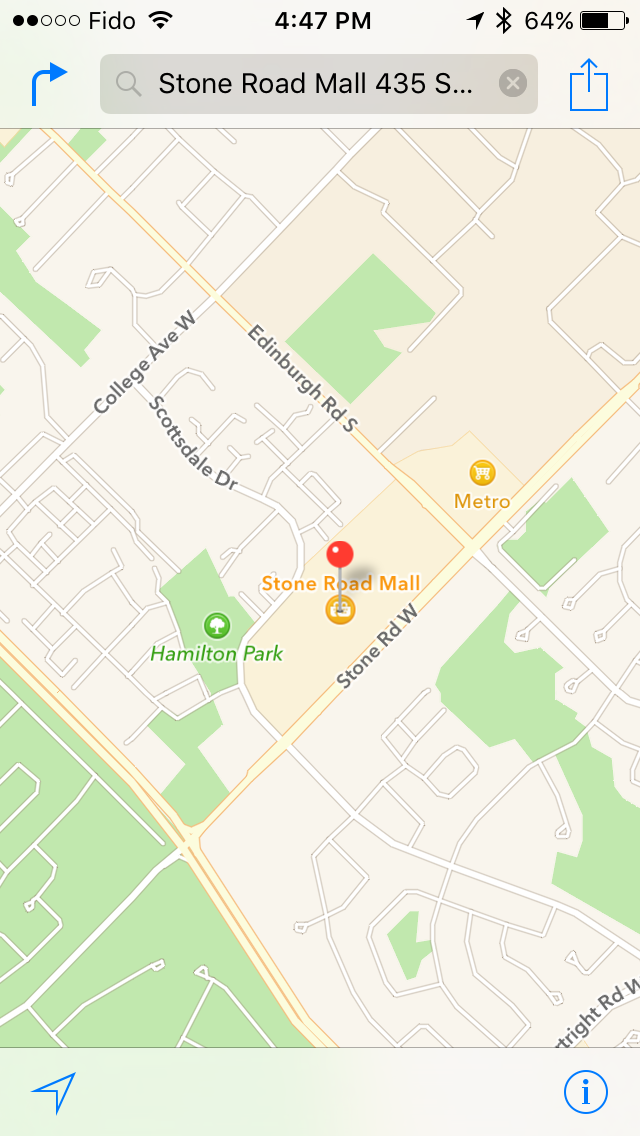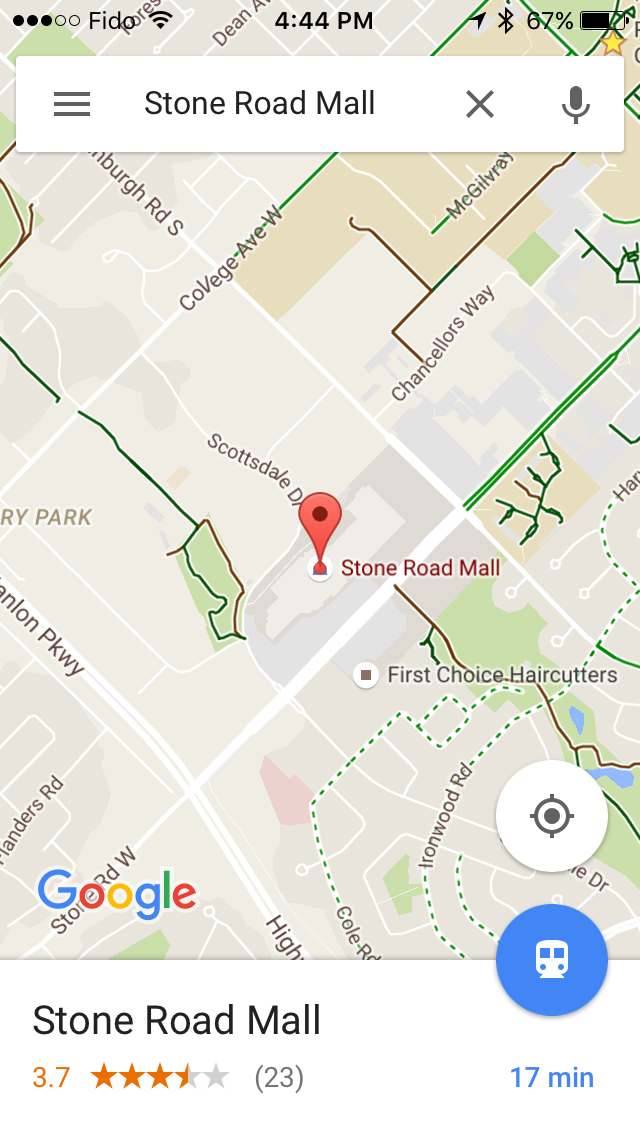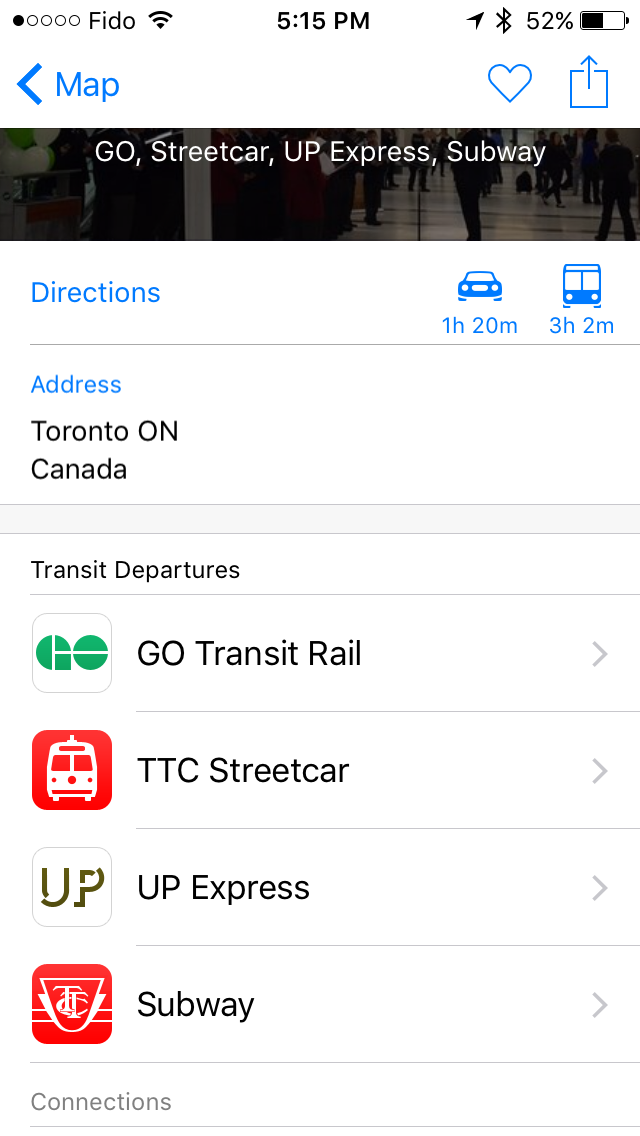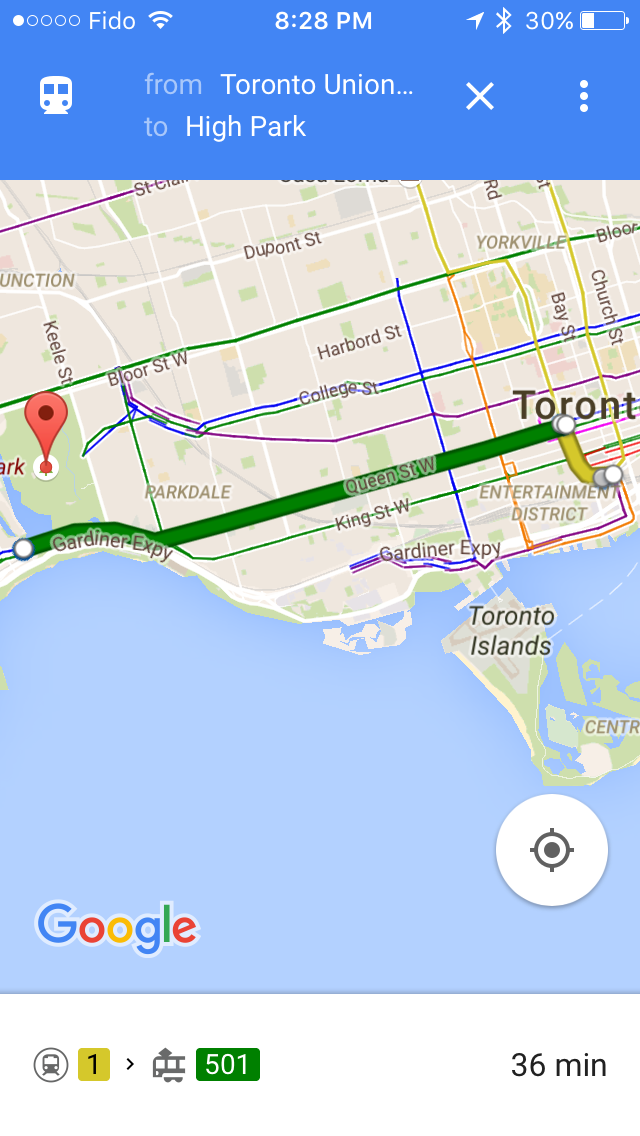The Apple iOS 9 Review
by Brandon Chester on September 16, 2015 8:00 AM EST- Posted in
- Smartphones
- Apple
- Mobile
- Tablets
- iOS 9
Apple Maps: Now With Transit
Apple Maps has been the butt of many jokes in the tech industry since its initial release with iOS 6. At that time it was clearly not ready to start shipping, and it paled in comparison to the previous maps app which used data from Google. Apple was forced to issue a public apology for the issues, and recommended that users use mapping services other than Apple Maps. Since that time, Apple has steadily improved their maps by acquiring companies, sending out cars to do manual mapping, and adding new sources of information for businesses. Even with their improvements, Apple Maps has still lagged behind Google Maps in some key areas, with one of them being built in directions for public transportation. With iOS 9 Apple has implemented their own transit directions right into the app, bringing back a feature that was lost with the switch from Google to their own mapping service three years ago.
Ever since the original Apple Maps release I have used Google Maps to find locations and get directions, as it provides the same experience on iOS and Android, and because public transit directions are something I need. With transit returning to maps on iOS, I thought it was worth going back to Apple Maps to see what improvements have been made in the last three years, and how it compares to Google Maps in my local area.
My first impression is that the Apple Maps application itself is better than Google Maps on any platform. Google Maps has always had fairly janky scrolling and zooming for me. Apple Maps definitely isn't devoid of stuttering, but it's normally significantly smoother than Google Maps. I find the aesthetics of the maps themselves to be nicer, and I think it's just due to the colors used and the fonts for the street names. The Apple Maps app also fits in better with iOS by following Apple's design and navigation guidelines, while Google Maps, like Google's other apps, feels like you're running an Android application and uses methods of navigation that are actively discouraged on iOS.
Google Maps certainly has a number of advantages though. I enjoy travelling by bike, and Google Maps has a really great overlay that shows you bike trails which are often submitted or edited based on user submissions. Apple Maps has no such thing, and I don't know how they would ever match the feature because it would require getting cyclists to submit to Apple Maps as well as Google, which will never occur to any meaningful extent. Google Maps also shows you the names of streets at a reasonable zoom level, while Apple Maps barely shows you any street names until you zoom so close that you don't even have a concept of where you are. The satellite imagery in Google Maps is also much better; it never turns to black and white like Apple Maps, and is noticeably higher in detail and resolution.
At the same time, Apple Maps has some advantages too. While it's very reluctant to put the names of streets, it lists many businesses and they all appear to be accurately placed. In contrast Google Maps does the same thing Apple Maps does with street names and makes only the ones it has arbitrarily chosen show up unless you zoom really close. If you're having to balance clutter I would probably choose to show street names rather than businesses though.
Both mapping apps actually had some issues with the accuracy of their mapping. Google Maps omits a ton of small streets that branch off of other streets, while Apple Maps marked a residential area as though it was a field. There are also some paths and roads that are marked in a questionable or incorrect manner in Apple Maps.
If I had to choose an application based solely on the quality and accuracy of the maps themselves, I would have to go with Google Maps. Apple Maps has improved greatly in my area since it originally launched, but Google has been in this business for far longer and they've collected and accurately marked a lot of data in that time. For my purposes Apple Maps is definitely sufficient, as I really treat my maps app more like a GPS device than a map, and so I was very interested to see what Apple has done with transit.
When Apple announced transit support at WWDC they did so in a somewhat confusing manner. It seemed that it would only support a handful of major cities, like New York, London, and Toronto. In reality, transit directions are supported in a great number of cities, and the ones specifically mentioned by Apple are the cities where they have created map overlays that show all the transit lines in the city. This is really not unlike the situation with Google Maps, where the cities that have transit overlays are big cities that have various types of public transport that run both above and below the ground. Clearly Google still has an advantage of scale, especially with Apple launching with few European and no Japanese cities, but these will be improved over time just like the maps themselves have been.
Of course, coming late to the party does give Apple a chance to think about what things could be done better about transit. For example, you can see above that when you select Toronto's Union Station in Apple Maps you're presented with a very clean view containing relevant info and sections for all the different transport services that run there. In contrast, Google's listing actually splits the station into five separate points on the map for the different transit services, and when you click on one the different transit lines are just laid out haphazardly.
The most amazing thing of all is that contrary to the reputation Apple Maps has, the transit directions and maps are accurate! Not only are they accurate, but I've seen several situations where they give a more sensible route than Google Maps has, and I even had to deal with this firsthand when travelling in Toronto earlier this year. Above you can see me trying to travel from Toronto's Union Station to High Park. Apple Maps presents a very logical route which takes the subway for the entire journey. For whatever reason, Google Maps suggests taking the subway for one section, and then taking a street car which results in a longer journey and also places you in a less convenient spot near a loud expressway on the other side of the park.
I've also noticed that in my city the algorithm Google Maps has used to map the journey of buses has made a number of errors. I see several cases where your route apparently takes you floating over a river, or through the middle of residential areas. While these may seem inconsequential, if the errors occur near the beginning end of your route it can be difficult to tell where you need to get or where you'll be let off. Google Maps also doesn't let you know when a route has been put on a detour due to construction, which is another way to end up missing the stop you want to get to. It really sounds crazy even to myself, but in my experiences I've seen Apple Maps constantly outperform Google Maps as a transit tool.
Now before anyone gets the wrong impression based on what I've written here, I want to reiterate that these are only my experiences. I can't travel too far to test out maps, and I live in a fairly urban area. I've heard and seen the stories of areas where Apple Maps is still mapped completely wrong, or where there's no map at all. I'm sure there are lots of stories that run contrary to my experience. However, with Apple Maps being used by 3.5x the number of users that Google Maps on iOS has, it's clear that a lot of users do find the default maps app to be satisfactory.
My big complaint now is that there are no bicycle routes, and that's an area where I predict Google will have a continued advantage. With that said, I think the better performance and better design of the Apple Maps app are serious points to consider as well. If you're someone who turned away from Apple Maps initially like I did I would encourage you to give it another try. If it's a disaster, then Google Maps is still there to provide great mapping info. However, I think the good aspects of Apple Maps may surprise you, as they surprised me.



















227 Comments
View All Comments
Speedfriend - Thursday, September 17, 2015 - link
@melgross I have recently seen numerous tablets being used by businesses (restaurants, delivery companies) that were clearly no-name Android tablets designed for that specific tasks. Why would a corporate that needs a tablet for a single task buy a $500 iPad when they can get a $200 Android?iPad is now caught in the middle between cheap single task Androids and multi-task windowns 2-in-1s. Our CEO is obsessed with Apple products but we have gone Windows tablets and it looks like we are going to go full surface range soon (3 and Pros). Why, because an iPad is too limited even as something you just take to meetings with you.
FunBunny2 - Wednesday, September 16, 2015 - link
-- a respected history of hardware-design and innovation..really, really now? Apple has always bought their silicon, 99.44% is off-the-shelf. Yeah, I know, the fanbois brag that the Ax chips are somehow blessed by Apple. Fact is: Apple only tweaked around the edges, using industry standard silicon design tools, a bit of cache added here and there. Just look at the BoM from any of the usual teardown sites. You'll see the fact: it's always other people's parts.
osxandwindows - Wednesday, September 16, 2015 - link
So why is apple not using 8core chips ha?Intervenator - Wednesday, September 16, 2015 - link
I hope that post was sarcastic or it would really be funny.damianrobertjones - Thursday, September 17, 2015 - link
...Because that would be too far a jump. Apple wants to MILK its customers for everything then can hence the small updates. Someone like Nokia committed a mortal sin as they released a 41Mp (36+5mp) camera phone while others are still messing with 20Mp.All about the cash.
P.s. Android NEEDS more cores as it runs like a bag of crap.
calden - Monday, September 28, 2015 - link
Actually Android runs just as smooth as iOS. The problem is skinned, custom versions of Android, i.e. TouchWiz. When I replaced TouchWiz with CM 12.1 on my Note 4, the system took up only 580MB, where as TouchWiz took up more than 1.5GB before a single app was even installed. I also installed the launcher SmartLauncher 3, the whole experience is lightning fast. Even when running multiple apps in the background, something iOS still can't do. I think it is ridiculous that a modern OS in 2015 cannot do something as simple as stream a movie to your TV and still allow you to use the device, iOS simply pauses, even disconnects the stream in some cases if you want to do something as simple as look up an actors name in IMDB. With my Android tablet I can not only stream a film to my TV but play a game like Modern Combat 5 at the same time. As a programmer I need to run a terminal app to stay connected to my firms server during trading hours as I have monitoring tools. IOS has terminal apps as well but I can't run them them in the background the entire day without iOS terminating it's connections. Again, I find this to be absolutely ridiculous as who wants to stare at a terminal the entire day, especially when I need access to my tablet or phone to do other tasks. Apple adding Pro behind the iPad doesn't automatically make it a pro device. IOS still has one of the worst document, file management systems on the market today. My Nokia 9500 from 2004 is light years better than what iOS provides, apps should never be allowed to manage their own files. Default apps, I still can't change the default apps in iOS, why? I have no use for Apple's included apps, if I had the choice I would immediately delete them from the system, as such I need the ability to select my own browser, email client, messenger, media player, etc. as the default applications. I find this tactic of not being able to select my own default apps in iOS highly anti-competitive. The EU went after Microsoft for including Internet Explorer in XP, even though the user had the option of choosing another browser as their default. Why hasn't Apple be scrutinized about this?calden - Monday, September 28, 2015 - link
I'm aware of those few audio and GPS apps that can run in the background in IOS, but this is a far cry than allowing any app that the user needs in the background. No, this has nothing to do with battery life, if it is than Apple really needs to rewrite iOS. My BlackBerry Passport, running three apps in the background, easily lasts the entire day on a single charge, actually it lasts a day and a half with moderate to heavy use. Android has the ability to select how many apps are allowed to run in the background, you can even set it to 1. So if people feel like their apps are eating up their battery they can control the amount of running apps. Apple could easily implement such a feature, they don't though, which means they have all the control, they dictate how the user uses their own devices. iOS is a wolf in sheep's clothing, looks pretty, inviting but once you start to do real work you encounter a brick wall a 20 stories high. How many times have you iOS users logged into iCloud on your device, I had to do it over 25 times to cover every app. Why, why do I need to log in even twice, once should be enough, in Android upon setting up my Google user that was it, from that point on every app that could communicate with Google Drive would automatically be setup. This is because the apps talk to the system at the lowest level, iOS requires spaghetti API's, a spiderweb of tunnels trying to pass info to each other. The Share TO function in iOS works only if the app dveloper has created a share profile. Why can't the system just dynamically create these Share To lists like Android 5.1.2, SailFish 2.0, Windows Mobile 10, BlackBerry OS 10.3.2 by looking for every compatible app that is installed and than listing. No, instead iOS uses this half ass API system. What about mult-user support, will never happen in iOS because of the way it handles files. To support multi-users in iOS each user would have to reinstall each app over again to distinguish each users. They could embed the users info in the file's metadata so the app can distinguish each user but that is just hacky at best would and how would these modified files react when used on other systems. IOS is definitely not a pro system and anyone thinking differently is either lying to themselves to protect their beloved Apple brand, aren't professionals themselves so don't reall understand the meaning or are working around these limitations, fighting the system at every point to get their work done which falls in line with point one, their lying to themselves.I'm not saying that iOS devices don't have their uses, they do. They make great consumer devices for media consumption, social media, gaming, drawing and other artistic apps, music and music creation, etc. However as a productivity tool these devices are highly limited and can't compete with the likes of a Surface Pro 3 or even Surface 3. Even an Android tablet would be a better option. With my Nexus 9 I can log into the LDAP and gain access to all my allowed users NAS storage, mount it as a local asset. Set file extensions to open up certain apps, etc. Trying to do this in iOS is like trying to put a round peg into a square one. You can do it with a bit of force but your going against it's designed purpose. Apple needs to completely rewrite iOS, combine many functions found in OSX before I would ever consider using another mobile device from Apple.
mikhapop - Monday, September 28, 2015 - link
you really nailed it, i am a web developer and i often fail to tell my friends how the ios is very limiting for even the basic stuff (my basic stuff). android is far better as far as the os go. Now i am using a surface pro 3 and never looked back, very good in meetings, and it is now my main machine for 98% of my work.blackcrayon - Wednesday, September 16, 2015 - link
Sounds like you know close to nothing about the Ax chips. They are custom Apple designs, and they also optimize their OS for them. I bet you thought Intrinsity and PA Semi were just marketing facades that didn't actually do anything before Apple acquired them years ago, right?KoolAidMan1 - Wednesday, September 16, 2015 - link
Apple spent billions acquiring semiconductor companies and is one of the few companies along with Qualcomm that has a license to make ARM chips. Anand himself highlighted this while showing that Apple's custom designs matched or exceeded Intel's Bay Trail.You really think their custom designs are something to be dismissed just because of the name on the package? The fanboy is strong in your posts